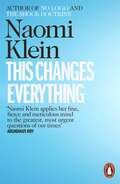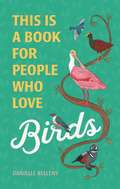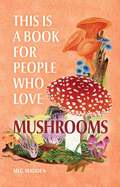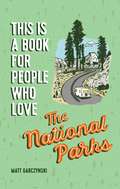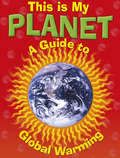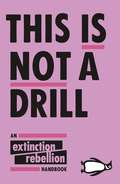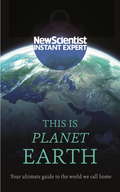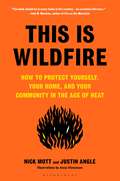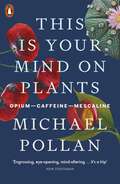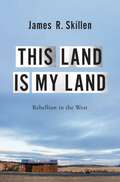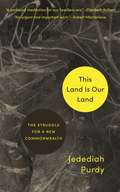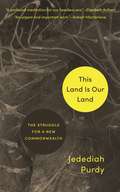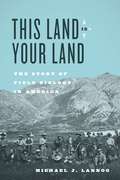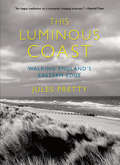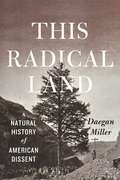- Table View
- List View
This Changes Everything: Capitalism vs. the Climate
by Naomi KleinNaomi Klein, author of the #1 international bestsellers, The Shock Doctrine and No Logo, returns with This Changes Everything, a must-read on how the climate crisis needs to spur transformational political changeWe seem to have given up on any serious effort to prevent catastrophic climate change. Despite mounting scientific evidence, denialism is surging in many wealthy countries, and extreme fossil-fuel extraction gathers pace. Exposing the work of ideologues on the right who know the challenge this poses to the free market all too well, Naomi Klein also challenges the failing strategies of environmental groups. This Changes Everything argues that the deep changes required should not be viewed as punishments to fear, but as a kind of gift. It's time to stop running from the full implications of the crisis and begin to embrace them. Naomi Klein is an award-winning journalist, syndicated columnist and author of the international bestsellers, The Shock Doctrine and No Logo. She is a member of the board of directors for 350.org, a global grassroots movement to solve the climate crisis, a Puffin Foundation Writing Fellow at The Nation Institute, and a former Miliband Fellow at the LSE. She holds an honorary Doctor of Civil Laws from the University of King's College, Nova Scotia.
This Is a Book for People Who Love Birds (This Is a Book for People Who Love)
by Danielle BellenyFull of bird watching basics, fun facts, and illustrated species profiles, This Is a Book for People Who Love Birds is a joyful celebration of our feathered friends!For seasoned spotters and backyard hobbyists alike, this charming guide offers an accessible look at the irresistible world of birding. Wildlife biologist and co-founder of Black Birders Week Danielle Belleny walks readers through the essentials of bird watching, from equipment to locations, offering new ideas for finding avian friends wherever you may be. Engaging profiles of North American bird species, from cardinals and blue jays to raptors and sea birds, are accompanied by whimsical illustrations sure to spark the imaginations of birders from coast to coast. Deeply researched and accessible to enthusiasts of all levels of experience, This Is a Book for People Who Love Birds is an essential addition to every bird lover's field library.
This Is a Book for People Who Love Mushrooms (This Is a Book for People Who Love)
by Meg MaddenA celebratory compendium of nature's weirdest and most wonderful fungi, with gorgeously illustrated profiles of notable mushrooms and information on foraging, understanding, and appreciating these magnificent living thingsFor amateur mycologists and experienced foragers alike, this delightful guide acts as a welcome to the wonderful world of mushrooms. From the most common and recognizable varieties frequently found in your supermarket aisle or backyard to the rarest, most fantastical offerings that look straight out of a fairytale illustration and everything in between, This Is a Book for People Who Love Mushrooms is a carefully researched, whimsically illustrated primer on a subject that naturalists are discovering more about each year. Accessible to enthusiasts of all levels, it is the perfect gift for the mushroom lover in your life.
This Is a Book for People Who Love the National Parks
by Matt GarczynskiSmart, short, and irresistibly illustrated, This Is a Book for People Who Love National Parks is a park-by-park celebration of the American outdoors.For devoted park-goers and casual campers alike, this charming guide is nothing short of a celebration of America's natural wonders. An introduction to the storied history of the Parks Service is paired with engaging profiles of each of the sixty-one National Parks, from Acadia to Zion and everything in between. Quirky facts and key dates are woven throughout, while refreshingly modern illustrations capture the iconic features of each majestic setting. Deeply researched but not too serious, This Is a Book for People Who Love National Parks is an essential addition to every park lover's field library.
This Is My Planet: This Is My Planet (This Is My Planet #1)
by Jan ThornhillWhy is global warming a problem? How do we know that Earth is heating up? Will climate change affect me? Can we stop it from getting worse? Is there something I can do to help?These are just some of the questions tackled in this intelligent and impassioned book about global warming and its impact on our Earth. By looking at the amazing interconnections between humans and our environment, readers will discover how even small actions can add up to make big changes.
This Is Not A Drill: An Extinction Rebellion Handbook
by Extinction RebellionExtinction Rebellion are inspiring a whole generation to take action on climate breakdown. Now you can become part of the movement - and together, we can make history.It's time. This is our last chance to do anything about the global climate and ecological emergency. Our last chance to save the world as we know it. Now or never, we need to be radical. We need to rise up. And we need to rebel.Extinction Rebellion is a global activist movement of ordinary people, demanding action from Governments. This is a book of truth and action. It has facts to arm you, stories to empower you, pages to fill in and pages to rip out, alongside instructions on how to rebel - from organising a roadblock to facing arrest. By the time you finish this book you will have become an Extinction Rebellion activist. Act now before it's too late.
This is Planet Earth: Your ultimate guide to the world we call home (New Scientist Instant Expert)
by New ScientistThe ancient Greeks called it Gaia; the Romans Terra. We know it simply as Earth, the planet we call home. And what a planet it is.Formed around 4.6 billion years ago from the debris of the big bang and long-dead stars, at first it was nothing special, but somehow it evolved to become the most amazing place in the known Universe. The only living planet we know of, it also has a very unusual moon, a remarkably dynamic surface, a complex atmosphere and a deeply mysterious interior.This is Planet Earth is dedicated to the wonders of Planet Earth. Its past is long and dramatic and its future shrouded in mystery. Yet despite centuries of research, only now are we starting to understand Earth's complexity.ABOUT THE SERIESNew Scientist Instant Expert books are definitive and accessible entry points to the most important subjects in science; subjects that challenge, attract debate, invite controversy and engage the most enquiring minds. Designed for curious readers who want to know how things work and why, the Instant Expert series explores the topics that really matter and their impact on individuals, society, and the planet, translating the scientific complexities around us into language that's open to everyone, and putting new ideas and discoveries into perspective and context.
This Is Wildfire: How to Protect Yourself, Your Home, and Your Community in the Age of Heat
by Nick Mott Justin AngleA practical guide for living with wildfire, including essential history and science, actions you can take to protect your home, and guiding principles for life in an increasingly fiery future.Wildfires are getting more destructive than ever before. Flames in forests are scorching about twice as many trees as they did two decades ago, and nearly 100,000 homes, barns, and other structures have been incinerated. “Fire seasons” are now fire years. Tens of millions of people live in areas vulnerable to fire, and more keep moving in. Driven in part by climate change, the areas burned and prevalence of smoke in the skies is expected to skyrocket in the decades to come. At the same time that wildfires leave swathes of the country in ash, they also renew. Wildfire is crucial for ecosystems to function and flourish. We're putting out many of the fires our landscape needs, and the ones that escape our control are devastating for forests and communities. It's clear what we're doing isn't working. Wildfire is inevitable, and we need to learn to live with it.The first of its kind, This Is Wildfire is required reading for our new reality. It offers everything you need to know about fire in one useful volume: reflects on the history of humanity's connection to flames; analyzes how our society arrived at this perilous moment; and recounts stories of those fighting fire and trying to change our relationship with it. It also offers practical advice: choosing your insurance and making your home resilient to burns; packing an emergency go-bag; rebuilding after a fire; and so much more.
This Is Your Mind On Plants: Opium—Caffeine—Mescaline
by Michael Pollan'It's a trip - engrossing, eye-opening, mind altering' New StatesmanFrom the international bestselling author of How to Change Your Mind ('A sweeping and often thrilling chronicle of the history of psychedelics' Guardian), comes a ground-breaking exploration of our relationship with natural drugsOf all the many things humans rely on plants for, surely the most curious is our use of them to change consciousness: to stimulate, calm, or completely alter the qualities of our mental experience. In This Is Your Mind On Plants, Michael Pollan explores three very different drugs - opium, caffeine and mescaline - and throws the fundamental strangeness of our thinking about them into sharp relief. Exploring and participating in the cultures that have grown up around these drugs, while consuming (or in the case of caffeine, trying not to consume) them, Pollan reckons with the powerful human attraction to psychoactive plants, and the equally powerful taboos. In a unique blend of history, science, memoir and reportage, Pollan shines a fresh light on a subject that is all too often treated reductively. In doing so, he proves that there is much more to say about these plants than simply debating their regulation, for when we take them into our bodies and let them change our minds, we are engaging with nature in one of the most profound ways we can. This ground-breaking and singular book holds up a mirror to our fundamental human needs and aspirations, the operations of our minds and our entanglement with the natural world.
This Land is My Land: Rebellion in the West
by James R. SkillenAmong American conservatives, the right to own property free from the meddling hand of the state is one of the most sacred rights of all. But in the American West, the federal government owns and oversees vast patches of land, complicating the narrative of western individualism and private property rights. As a consequence, anti-federal government sentiment has animated conservative politics in the West for decades upon decades. In This Land Is My Land, James R. Skillen tells the story of conservative rebellion-ranging from legal action to armed confrontations-against federal land management in the American West over the last forty years. He traces the successive waves of conservative insurgency against federal land authority-the Sagebrush Rebellion (1979-1982), the War for the West (1991-2000), and the Patriot Rebellion (2009-2016)-and shows how they evolved from regional revolts waged by westerners with material interests in federal lands to a national rebellion against the federal administrative state. Cumulatively, Skillen explains how ranchers, miners, and other traditional users of federal lands became powerful symbols of conservative America and inseparably linked to issues of property rights, gun rights, and religious expression. Not just a book about property rights battles over Western lands, This Land is My Land reveals how the evolving land-based conflicts in the West since the 1980s reshaped the conservative coalition in America-a development that ultimately helped lead to the election of President Donald J. Trump in 2016.
This Land is My Land: Rebellion in the West
by James R. SkillenAmong American conservatives, the right to own property free from the meddling hand of the state is one of the most sacred rights of all. But in the American West, the federal government owns and oversees vast patches of land, complicating the narrative of western individualism and private property rights. As a consequence, anti-federal government sentiment has animated conservative politics in the West for decades upon decades. In This Land Is My Land, James R. Skillen tells the story of conservative rebellion-ranging from legal action to armed confrontations-against federal land management in the American West over the last forty years. He traces the successive waves of conservative insurgency against federal land authority-the Sagebrush Rebellion (1979-1982), the War for the West (1991-2000), and the Patriot Rebellion (2009-2016)-and shows how they evolved from regional revolts waged by westerners with material interests in federal lands to a national rebellion against the federal administrative state. Cumulatively, Skillen explains how ranchers, miners, and other traditional users of federal lands became powerful symbols of conservative America and inseparably linked to issues of property rights, gun rights, and religious expression. Not just a book about property rights battles over Western lands, This Land is My Land reveals how the evolving land-based conflicts in the West since the 1980s reshaped the conservative coalition in America-a development that ultimately helped lead to the election of President Donald J. Trump in 2016.
This Land Is Our Land: The Struggle for a New Commonwealth
by Jedediah PurdyFrom one of our finest writers and leading environmental thinkers, a powerful book about how the land we share divides us—and how it could unite usToday, we are at a turning point as we face ecological and political crises that are rooted in conflicts over the land itself. But these problems can be solved if we draw on elements of our tradition that move us toward a new commonwealth—a community founded on the well-being of all people and the natural world. In this brief, powerful, timely, and hopeful book, Jedediah Purdy, one of our finest writers and leading environmental thinkers, explores how we might begin to heal our fractured and contentious relationship with the land and with each other.From the coalfields of Appalachia and the tobacco fields of the Carolinas to the public lands of the West, Purdy shows how the land has always united and divided Americans, holding us in common projects and fates but also separating us into insiders and outsiders, owners and dependents, workers and bosses. Expropriated from Native Americans and transformed by slave labor, the same land that represents a history of racism and exploitation could, in the face of environmental catastrophe, bind us together in relationships of reciprocity and mutual responsibility.This may seem idealistic in our polarized time, but we are at a historical fork in the road, and if we do not make efforts now to move toward a commonwealth, Purdy warns, environmental and political pressures will create harsher and crueler conflicts—between citizens, between countries, and between humans and the rest of the world.
This Land Is Our Land: The Struggle for a New Commonwealth
by Jedediah PurdyFrom one of our finest writers and leading environmental thinkers, a powerful book about how the land we share divides us—and how it could unite usToday, we are at a turning point as we face ecological and political crises that are rooted in conflicts over the land itself. But these problems can be solved if we draw on elements of our tradition that move us toward a new commonwealth—a community founded on the well-being of all people and the natural world. In this brief, powerful, timely, and hopeful book, Jedediah Purdy, one of our finest writers and leading environmental thinkers, explores how we might begin to heal our fractured and contentious relationship with the land and with each other.From the coalfields of Appalachia and the tobacco fields of the Carolinas to the public lands of the West, Purdy shows how the land has always united and divided Americans, holding us in common projects and fates but also separating us into insiders and outsiders, owners and dependents, workers and bosses. Expropriated from Native Americans and transformed by slave labor, the same land that represents a history of racism and exploitation could, in the face of environmental catastrophe, bind us together in relationships of reciprocity and mutual responsibility.This may seem idealistic in our polarized time, but we are at a historical fork in the road, and if we do not make efforts now to move toward a commonwealth, Purdy warns, environmental and political pressures will create harsher and crueler conflicts—between citizens, between countries, and between humans and the rest of the world.
This Land Is Our Land: The Struggle for a New Commonwealth
by Jedediah PurdyFrom one of our finest writers and leading environmental thinkers, a powerful book about how the land we share divides us—and how it could unite usToday, we are at a turning point as we face ecological and political crises that are rooted in conflicts over the land itself. But these problems can be solved if we draw on elements of our tradition that move us toward a new commonwealth—a community founded on the well-being of all people and the natural world. In this brief, powerful, timely, and hopeful book, Jedediah Purdy explores how we might begin to heal our fractured and contentious relationship with the land and with each other.
This Land Is Our Land: The Struggle for a New Commonwealth
by Jedediah PurdyFrom one of our finest writers and leading environmental thinkers, a powerful book about how the land we share divides us—and how it could unite usToday, we are at a turning point as we face ecological and political crises that are rooted in conflicts over the land itself. But these problems can be solved if we draw on elements of our tradition that move us toward a new commonwealth—a community founded on the well-being of all people and the natural world. In this brief, powerful, timely, and hopeful book, Jedediah Purdy explores how we might begin to heal our fractured and contentious relationship with the land and with each other.
This Land Is Your Land: The Story of Field Biology in America
by Michael J. LannooField biology is enjoying a resurgence due to several factors, the most important being the realization that there is no ecology, no conservation, and no ecosystem restoration without an understanding of the basic relationships between species and their environments—an understanding gleaned only through field-based natural history. With this resurgence, modern field biologists find themselves asking fundamental existential questions such as: Where did we come from? What is our story? Are we part of a larger legacy? In This Land Is Your Land, seasoned field biologist Michael J. Lannoo answers these questions and more in a tale rooted in the people and institutions of the Midwest. It is a story told from the ground up, a rubber boot–based natural history of field biology in America. Lannoo illuminates characters such as John Wesley Powell, William Temple Hornaday, and Olaus and Adolph Murie—homegrown midwestern field biologists who either headed east to populate major research centers or went west to conduct their fieldwork along the frontier. From the pioneering work of Victor Shelford, Henry Chandler Cowles, and Aldo Leopold to contemporary insights from biologists such as Jim Furnish and historians such as William Cronon, Lannoo’s unearthing of American—and particularly midwestern—field biologists reveals how these scientists influenced American ecology, conservation biology, and restoration ecology, and in turn drove global conservation efforts through environmental legislation and land set-asides. This Land Is Your Land reveals the little-known legacy of midwestern field biologists, whose ethos and discoveries have enabled us to preserve and understand not just their land, but all lands.
This Land Is Your Land: The Story of Field Biology in America
by Michael J. LannooField biology is enjoying a resurgence due to several factors, the most important being the realization that there is no ecology, no conservation, and no ecosystem restoration without an understanding of the basic relationships between species and their environments—an understanding gleaned only through field-based natural history. With this resurgence, modern field biologists find themselves asking fundamental existential questions such as: Where did we come from? What is our story? Are we part of a larger legacy? In This Land Is Your Land, seasoned field biologist Michael J. Lannoo answers these questions and more in a tale rooted in the people and institutions of the Midwest. It is a story told from the ground up, a rubber boot–based natural history of field biology in America. Lannoo illuminates characters such as John Wesley Powell, William Temple Hornaday, and Olaus and Adolph Murie—homegrown midwestern field biologists who either headed east to populate major research centers or went west to conduct their fieldwork along the frontier. From the pioneering work of Victor Shelford, Henry Chandler Cowles, and Aldo Leopold to contemporary insights from biologists such as Jim Furnish and historians such as William Cronon, Lannoo’s unearthing of American—and particularly midwestern—field biologists reveals how these scientists influenced American ecology, conservation biology, and restoration ecology, and in turn drove global conservation efforts through environmental legislation and land set-asides. This Land Is Your Land reveals the little-known legacy of midwestern field biologists, whose ethos and discoveries have enabled us to preserve and understand not just their land, but all lands.
This Land Is Your Land: The Story of Field Biology in America
by Michael J. LannooField biology is enjoying a resurgence due to several factors, the most important being the realization that there is no ecology, no conservation, and no ecosystem restoration without an understanding of the basic relationships between species and their environments—an understanding gleaned only through field-based natural history. With this resurgence, modern field biologists find themselves asking fundamental existential questions such as: Where did we come from? What is our story? Are we part of a larger legacy? In This Land Is Your Land, seasoned field biologist Michael J. Lannoo answers these questions and more in a tale rooted in the people and institutions of the Midwest. It is a story told from the ground up, a rubber boot–based natural history of field biology in America. Lannoo illuminates characters such as John Wesley Powell, William Temple Hornaday, and Olaus and Adolph Murie—homegrown midwestern field biologists who either headed east to populate major research centers or went west to conduct their fieldwork along the frontier. From the pioneering work of Victor Shelford, Henry Chandler Cowles, and Aldo Leopold to contemporary insights from biologists such as Jim Furnish and historians such as William Cronon, Lannoo’s unearthing of American—and particularly midwestern—field biologists reveals how these scientists influenced American ecology, conservation biology, and restoration ecology, and in turn drove global conservation efforts through environmental legislation and land set-asides. This Land Is Your Land reveals the little-known legacy of midwestern field biologists, whose ethos and discoveries have enabled us to preserve and understand not just their land, but all lands.
This Land Is Your Land: The Story of Field Biology in America
by Michael J. LannooField biology is enjoying a resurgence due to several factors, the most important being the realization that there is no ecology, no conservation, and no ecosystem restoration without an understanding of the basic relationships between species and their environments—an understanding gleaned only through field-based natural history. With this resurgence, modern field biologists find themselves asking fundamental existential questions such as: Where did we come from? What is our story? Are we part of a larger legacy? In This Land Is Your Land, seasoned field biologist Michael J. Lannoo answers these questions and more in a tale rooted in the people and institutions of the Midwest. It is a story told from the ground up, a rubber boot–based natural history of field biology in America. Lannoo illuminates characters such as John Wesley Powell, William Temple Hornaday, and Olaus and Adolph Murie—homegrown midwestern field biologists who either headed east to populate major research centers or went west to conduct their fieldwork along the frontier. From the pioneering work of Victor Shelford, Henry Chandler Cowles, and Aldo Leopold to contemporary insights from biologists such as Jim Furnish and historians such as William Cronon, Lannoo’s unearthing of American—and particularly midwestern—field biologists reveals how these scientists influenced American ecology, conservation biology, and restoration ecology, and in turn drove global conservation efforts through environmental legislation and land set-asides. This Land Is Your Land reveals the little-known legacy of midwestern field biologists, whose ethos and discoveries have enabled us to preserve and understand not just their land, but all lands.
This Land Is Your Land: The Story of Field Biology in America
by Michael J. LannooField biology is enjoying a resurgence due to several factors, the most important being the realization that there is no ecology, no conservation, and no ecosystem restoration without an understanding of the basic relationships between species and their environments—an understanding gleaned only through field-based natural history. With this resurgence, modern field biologists find themselves asking fundamental existential questions such as: Where did we come from? What is our story? Are we part of a larger legacy? In This Land Is Your Land, seasoned field biologist Michael J. Lannoo answers these questions and more in a tale rooted in the people and institutions of the Midwest. It is a story told from the ground up, a rubber boot–based natural history of field biology in America. Lannoo illuminates characters such as John Wesley Powell, William Temple Hornaday, and Olaus and Adolph Murie—homegrown midwestern field biologists who either headed east to populate major research centers or went west to conduct their fieldwork along the frontier. From the pioneering work of Victor Shelford, Henry Chandler Cowles, and Aldo Leopold to contemporary insights from biologists such as Jim Furnish and historians such as William Cronon, Lannoo’s unearthing of American—and particularly midwestern—field biologists reveals how these scientists influenced American ecology, conservation biology, and restoration ecology, and in turn drove global conservation efforts through environmental legislation and land set-asides. This Land Is Your Land reveals the little-known legacy of midwestern field biologists, whose ethos and discoveries have enabled us to preserve and understand not just their land, but all lands.
This Land Is Your Land: The Story of Field Biology in America
by Michael J. LannooField biology is enjoying a resurgence due to several factors, the most important being the realization that there is no ecology, no conservation, and no ecosystem restoration without an understanding of the basic relationships between species and their environments—an understanding gleaned only through field-based natural history. With this resurgence, modern field biologists find themselves asking fundamental existential questions such as: Where did we come from? What is our story? Are we part of a larger legacy? In This Land Is Your Land, seasoned field biologist Michael J. Lannoo answers these questions and more in a tale rooted in the people and institutions of the Midwest. It is a story told from the ground up, a rubber boot–based natural history of field biology in America. Lannoo illuminates characters such as John Wesley Powell, William Temple Hornaday, and Olaus and Adolph Murie—homegrown midwestern field biologists who either headed east to populate major research centers or went west to conduct their fieldwork along the frontier. From the pioneering work of Victor Shelford, Henry Chandler Cowles, and Aldo Leopold to contemporary insights from biologists such as Jim Furnish and historians such as William Cronon, Lannoo’s unearthing of American—and particularly midwestern—field biologists reveals how these scientists influenced American ecology, conservation biology, and restoration ecology, and in turn drove global conservation efforts through environmental legislation and land set-asides. This Land Is Your Land reveals the little-known legacy of midwestern field biologists, whose ethos and discoveries have enabled us to preserve and understand not just their land, but all lands.
This Luminous Coast: Walking England's Eastern Edge
by Jules PrettyOver the course of a year, Jules Pretty walked along the shoreline of East Anglia in southeastern England, eventually exploring four hundred miles on foot (and another hundred miles by boat). It is a coast and a culture that is about to be lost—not yet, perhaps, but soon—to rising tides and industrial sprawl. This Luminous Coast takes the reader with him on his journey over land and water; over sea walls of dried grass, beside stretched fields of golden crops, alongside white sails gliding across the intricate lacework of invisible creeks and estuaries, under vast skies that are home to curlews and redshanks and the outpourings of skylarks. East Anglia’s coastline is as much a human landscape as it is a natural one, and Pretty is equally perceptive about the region’s cultural heritage and its "industrial wild": fishing villages and the modern seaside resorts, family farms and oil refineries, pleasure piers and concrete seawalls, cozy pubs and military installations. Through words and photographs, Pretty interweaves stories of the land and sea with people past and present. He is a passionate and sensitive guide to a region in transition, under stress, and perhaps even doomed, as finely attuned to its history as he is to its unique sensory world.
This Radical Land: A Natural History of American Dissent
by Daegan Miller“The American people sees itself advance across the wilderness, draining swamps, straightening rivers, peopling the solitude, and subduing nature,” wrote Alexis de Tocqueville in 1835. That’s largely how we still think of nineteenth-century America today: a country expanding unstoppably, bending the continent’s natural bounty to the national will, heedless of consequence. A country of slavery and of Indian wars. There’s much truth in that vision. But if you know where to look, you can uncover a different history, one of vibrant resistance, one that’s been mostly forgotten. This Radical Land recovers that story. Daegan Miller is our guide on a beautifully written, revelatory trip across the continent during which we encounter radical thinkers, settlers, and artists who grounded their ideas of freedom, justice, and progress in the very landscapes around them, even as the runaway engine of capitalism sought to steamroll everything in its path. Here we meet Thoreau, the expert surveyor, drawing anticapitalist property maps. We visit a black antislavery community in the Adirondack wilderness of upstate New York. We discover how seemingly commercial photographs of the transcontinental railroad secretly sent subversive messages, and how a band of utopian anarchists among California’s sequoias imagined a greener, freer future. At every turn, everyday radicals looked to landscape for the language of their dissent—drawing crucial early links between the environment and social justice, links we’re still struggling to strengthen today. Working in a tradition that stretches from Thoreau to Rebecca Solnit, Miller offers nothing less than a new way of seeing the American past—and of understanding what it can offer us for the present . . . and the future.
This Radical Land: A Natural History of American Dissent
by Daegan Miller“The American people sees itself advance across the wilderness, draining swamps, straightening rivers, peopling the solitude, and subduing nature,” wrote Alexis de Tocqueville in 1835. That’s largely how we still think of nineteenth-century America today: a country expanding unstoppably, bending the continent’s natural bounty to the national will, heedless of consequence. A country of slavery and of Indian wars. There’s much truth in that vision. But if you know where to look, you can uncover a different history, one of vibrant resistance, one that’s been mostly forgotten. This Radical Land recovers that story. Daegan Miller is our guide on a beautifully written, revelatory trip across the continent during which we encounter radical thinkers, settlers, and artists who grounded their ideas of freedom, justice, and progress in the very landscapes around them, even as the runaway engine of capitalism sought to steamroll everything in its path. Here we meet Thoreau, the expert surveyor, drawing anticapitalist property maps. We visit a black antislavery community in the Adirondack wilderness of upstate New York. We discover how seemingly commercial photographs of the transcontinental railroad secretly sent subversive messages, and how a band of utopian anarchists among California’s sequoias imagined a greener, freer future. At every turn, everyday radicals looked to landscape for the language of their dissent—drawing crucial early links between the environment and social justice, links we’re still struggling to strengthen today. Working in a tradition that stretches from Thoreau to Rebecca Solnit, Miller offers nothing less than a new way of seeing the American past—and of understanding what it can offer us for the present . . . and the future.
This Radical Land: A Natural History of American Dissent
by Daegan Miller“The American people sees itself advance across the wilderness, draining swamps, straightening rivers, peopling the solitude, and subduing nature,” wrote Alexis de Tocqueville in 1835. That’s largely how we still think of nineteenth-century America today: a country expanding unstoppably, bending the continent’s natural bounty to the national will, heedless of consequence. A country of slavery and of Indian wars. There’s much truth in that vision. But if you know where to look, you can uncover a different history, one of vibrant resistance, one that’s been mostly forgotten. This Radical Land recovers that story. Daegan Miller is our guide on a beautifully written, revelatory trip across the continent during which we encounter radical thinkers, settlers, and artists who grounded their ideas of freedom, justice, and progress in the very landscapes around them, even as the runaway engine of capitalism sought to steamroll everything in its path. Here we meet Thoreau, the expert surveyor, drawing anticapitalist property maps. We visit a black antislavery community in the Adirondack wilderness of upstate New York. We discover how seemingly commercial photographs of the transcontinental railroad secretly sent subversive messages, and how a band of utopian anarchists among California’s sequoias imagined a greener, freer future. At every turn, everyday radicals looked to landscape for the language of their dissent—drawing crucial early links between the environment and social justice, links we’re still struggling to strengthen today. Working in a tradition that stretches from Thoreau to Rebecca Solnit, Miller offers nothing less than a new way of seeing the American past—and of understanding what it can offer us for the present . . . and the future.
